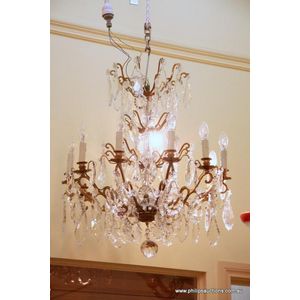1920s French Crystal Birdcage Chandelier
You must be a subscriber, and be logged in to view price and dealer details.
Subscribe Now to view actual auction price for this item
When you subscribe, you have the option of setting the currency in which to display prices to $Au, $US, $NZ or Stg.
- Floral Swag / Garland / Festoon - Floral swags are a decorative motif often used in the ornamentation of various objects, such as silverware, glassware, and furniture. The term "swag" refers to a garland or wreath of flowers, foliage, or other decorative elements, which is usually arranged in a loop or curve.
Floral swags can be found in a variety of decorative styles, from ornate Baroque and Rococo designs to more naturalistic Art Nouveau and Art Deco styles. They are often used to add a touch of elegance, refinement, or whimsy to an object, and can be seen on a range of items from chandeliers and candlesticks to picture frames and tea sets.
In the decoration of silver objects, floral swags are often used to accentuate the curves and lines of the piece, and to add visual interest to the surface. Similarly, on glass objects, floral swags may be used to frame or highlight a particular area of the object, or to add a touch of color and delicacy.
On furniture, floral swags can be found on a variety of pieces, from cabinets and armoires to chairs and sofas. They are often used to enhance the lines and curves of the furniture, and can be used to create a sense of movement and flow in the design.
Overall, floral swags are a versatile decorative element that can be adapted to a range of styles and applications, and have been used in the decoration of various objects throughout history. - Oviform /ovoid - The outline loosely resembling the shape of an egg.
- Circa - A Latin term meaning 'about', often used in the antique trade to give an approximate date for the piece, usually considered to be five years on either side of the circa year. Thus, circa 1900 means the piece was made about 1900, probably between 1895 and 1905. The expression is sometimes abbreviated to c.1900.
This item has been included into following indexes:
Visually similar items

A fine French crystal chandelier, 19th century, a tiered basket style chandelier hung with crimped pear and bell shaped drops and rosettes and a crystal orb finial, with ten curvaceous and slender bronze arms with electrified candles. Height 80 cm. Diamete

A French gilt metal and crystal chandelier, circa 1920. Basket shape with six arms, terminating in cone and candle lights, all with facetted prisms. 50 cm high, 49 cm diameter.

An Edwardian three tier walnut corner whatnot, early 20th century, the shaped tiers with boxwood and ebony inlay, a fretwork gallery to the upper tier, turned and spiral twist supports and finials upon turned ball feet, height 110 cm

A Venetian style etched glass wall mirror 160 x 110 cm
